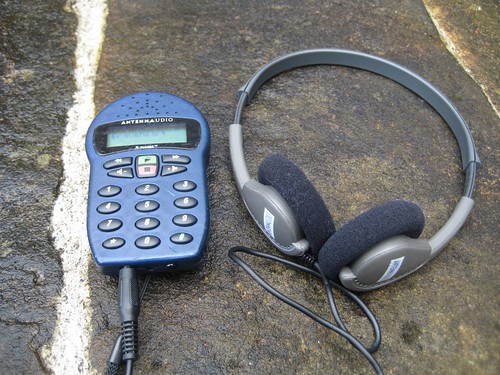Perhaps I have been out of the sight-seeing game for a while (admittedly, the last time I was a somewhat full-time tourist was on a 4-month work exchange program in London, in the summer of, er... 1988). But I was still surprised at the proliferation of this new (to me) technology. For the uninitiated, an audioguide (or audio guide... whatever) is a small digital audio device that plays pre-recorded information about some point of interest at whatever sight you're touring. They're usually available in many different languages (happily, one of these is always English). Around the sight are placards telling you what number to enter into your device to hear commentary appropriate to that particular location. So far I've seen or used audioguides at: Westminster Abbey, The Cabinet War Rooms and Churchill Museum, the British Museum, The National Gallery, Deal Castle, Edinburgh Castle, the Royal Yacht Britannia, The Palace of Holyroodhouse, the National Museum of Scotland, the Falkirk Wheel, and Stirling Castle. And I'm just getting started.
I've encountered two types of guides. There are small ones into which you plug headphones, like this one from Stirling Castle:
There are also long skinny ones that are designed to be held up to your ear like a phone receiver, and look like a cross between a 1980s "brick" cell phone and a billy club. Both varieties come with a lanyard which enables you to hang them around your neck, which is convenient and allows you to look like a kind of low-rent proto-Borg in the process.
Audioguides have advantages. They let you wander through a sight at your own pace and by your own route. You can linger where you want, and take breaks when it pleases you. Often there are opportunities to hear more about something that interests you, and, more importantly, you can skip bits that are unutterably boring ("This 18th century snuffbox is thought to have belonged to The Reverend Major Sir Clarence Billingsley-Crapslump, CBE, 11th Earl of Snorkington-on-the-Whiffey... blah blah...noted amateur phrenologist... blah blah blah... East India campaigns... blah blah... His Majesty's Own Highland blah blah... 97th Brigade Fusilier and Pea-shooter Corps blah blah blah..."). It's all pretty handy, and I'm sure it saves places loads of money not having to keep actual people around to elaborate on this sort of thing.
But audioguides have disadvantage too. I noticed the first when I spent the afternoon at Edinburgh Castle. Maybe it's just my naturally orderly (read: Type A) personality, but I really felt compelled to seek out every little placard and listen to every second of commentary that was on offer. This made for a long day, and led to a certain tourist-fatigue with which I am becoming increasingly familiar.
The other disadvantage was one I noticed when I toured the Royal Yacht Britannia in Edinburgh. The yacht was great - you get to wander all over and see everything from the Royal apartments to the officer's and enlisted men's quarters to the kitchens and engine room. The admission fee included the inevitable audioguide, which was actually quite good, and not as overwhelming as the one at the castle. What bugged me was that I was touring the boat with a lot of other people, but I might as well have been completely alone. In every room I entered there would be two or five or nine people, all listening intently to their audioguides, but not interacting at all with each other. There were even staff members hanging about, but no one talked to them either. It was all a bit eerie, especially since you could tell what bit of commentary each person was listening to by how they moved around the room ("Look to your left at the cabinet of silver in the corner..." was accompanied by a constant tide of people dutifully drifting towards the cabinet on the left.). It was like we were all on a very slow, perfectly silent, and somewhat funereal Royal Yacht Britannia carnival ride.
Happily, a lot of major sights still offer personally guided tours conducted by actual sentient, responsive beings who, besides commenting on the exhibits in great depth, will also attempt to answer quirky questions not covered in pre-recorded snippets, and laugh at my jokes, and point the way to bathrooms and nearby pubs. I make it a policy to take guided tours whenever they're available, and I haven't been disappointed by one yet. (Though the guy at Stirling Castle was a bit odd. He had an anecdote to relate about the home town of any person in the group. I'm not kidding, there were people from Vienna, Wisconsin, all over. His anecdote about Manitoba had something to do with getting honey from Winnipeg during winters when he was a child. Also he had a strange, almost caricaturish manner of speech that is impossible to convey in print, but reminded me a bit of John Cleese, though in a disquieting rather than a funny way.)
I suppose I'm in favour of audioguides overall, as long as they're used with discretion. It seems they're inevitable anyways, so I'll keep on using them, as long as I can still flag down the occasional living human to point the way to the exit closest to a convivial pub.





2 Comments:
Your words paint strong images of the people silently moving around that yacht. I think this isn't just happening with audioguides though, I run into similar situations nearly every day while walking the dog. I start to say good morning to someone and then see their ipod wires. Down goes my head and I walk on by.
I agree with you! Just finished an audio guide tour of Pablo Neruda's Valparaiso house and there we all were, wandering around like silent cyborgs. I do like a guided tour though and appreciate the extra information any 'tour' can give me - I have wandered aimlessly around enough sites and not really understood the significance.
Cheers!!
Post a Comment